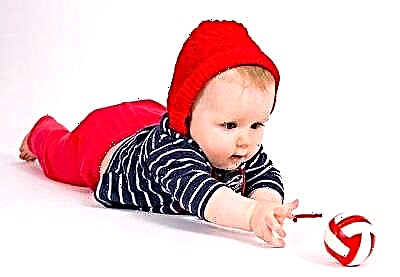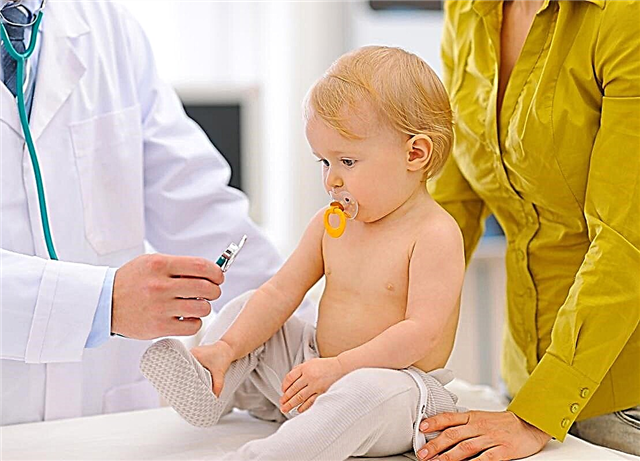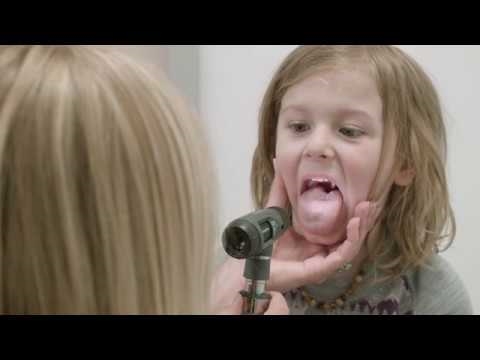
In the first year, the development of the baby is very rapid. The crumb constantly pleases with new skills and small achievements. A five month old baby is very different from a newborn toddler. What has the baby learned by 5 months of age and how can parents stimulate the development of a baby at 5 months?

Physiological changes
- The constitution of an infant at 5 months becomes more proportional, and the muscles are significantly strengthened.
- The child's vision continues to develop. Neither stationary nor fast moving objects can escape the baby's eyes. The baby also likes to look at pictures.
- A 5-month-old child has a lot of saliva, which is not only associated with the upcoming teething, but also helps to clean the oral cavity, because the baby pulls almost all objects that fall into his hands into his mouth. Teething can cause significant discomfort long before the appearance of the first tooth: the baby may sleep poorly, lose appetite, and be capricious due to pain in the gums.
Cholisal triple action dental gel can be used to relieve the symptoms of teething.®... When applied topically, the active ingredients of the drug are absorbed through the mucous membrane of the oral cavity, helping to relieve pain and inflammation, as well as acting on viruses, fungi and pathogenic bacteria. The adhesive gel base helps to retain the active substances on the mucous membrane, prolonging their action. It should be noted that Cholisal gel® does not contain lidocaine, and can be recommended for patients with lidocaine intolerance. Unlike some other local antiseptic and anti-inflammatory drugs, Cholisal® can be used in both adults and children. It is important to be careful when using in children under one year old and consult a doctor first.
- The stool of a child who is fed only breast milk can be either frequent (5-6 times a day) or rare (once every 2-5 days). Babies who are formula-fed or started to receive complementary foods usually defecate 1-2 times a day, and their feces are more dense and pungent.
- Urination at 5 months of age is normal up to 15 times a day.
Hypertonicity inherent in newborns usually disappears completely by the age of 5 months.
Physical development
During the fifth month of life, the child adds about 700 grams, and his height increases by an average of 2 centimeters. Chest circumference begins to prevail over head circumference.

Each baby develops at its own pace, but experts have determined the average indicators that are characteristic of most children of a certain age. Having learned them, you will be able to find out whether the child is growing normally and whether additional medical advice is needed.
We have collected the normal range and average values for 5-month-old babies in the following table:
You can use the calculator to calculate norms for your child... The calculator is based on the standards for height and weight from the World Health Organization (WHO).
What can the kid do?
- The baby has mastered the flips on the back from the position on the tummy. Now the child himself chooses the position in which he will study the world around him. Some kids have started to master crawling. While they are trying to move on their stomachs, actively moving their legs, and also roll over.
- The baby can already sit, but only with support (for example, in a highchair). At the same time, the back of the crumbs is bent, so doctors do not recommend leaving a 5-month-old child in a sitting position for a long time. If you hold the baby under your arms and place it on a solid surface, you will notice that the baby will be standing on straight legs.
- The crumb freely controls its handles and is able to both grab and hold objects for a long time with both hands. Invite your child to take a toy and see how the baby grabs it with a handle. The baby will carefully study the subject and can get so carried away that he will spend up to 10-15 minutes with the toy.
- The toddler is already getting to know his mother and other people with whom he often communicates. He briskly responds to expressions of attention from loved ones and distinguishes the tone with which they communicate with him. Strangers, on the other hand, cause a completely different reaction in the child, mostly alert.
- The baby's speech is actively developing and is a prolonged humming. In the sounds uttered by the tiny one, one can already note a certain intonation, which the child copies from the parents. Some kids already pronounce not individual sounds, but syllables.
- The little one really likes songs and nursery rhymes from mother's lips, which is manifested by stormy fun. Just as violently, the little one knows how to express negative emotions, for example, when they took a toy or put it in a crib, and the child still wanted to talk to his mother.
- The kid began to take an interest in adult food. He looks into the plates of mom and dad, and if parents like the idea of pedagogical complementary foods, this behavior can be a reason to start introducing the baby to the first portions of new food.
You can do the exercises shown in the following video, according to the methodology of O. N. Teplyakova, an expert in intellectual development.
Development activities
- Spend about 10 minutes daily gymnastics, since this will help the baby to strengthen the muscles (especially now it is important to strengthen the baby's back) and learn how to control his own body. Spread your baby's arms to the sides and cross them on the chest, then pull the baby by the arms to give him a sitting position. After that, move the baby's legs, turn the baby over on its stomach and work out in this position.
- Place a bright toy close to the baby to encourage crawling. so that the baby could not reach her with his hands, but was forced to try to crawl a little. Place a palm under the toddler's legs, from which the child can push off.
- Massage by 5 months of age becomes a little more difficult. The baby's body can now not only be stroked and rubbed, but also pinched, kneaded and beaten.
- Continue training on fitball, after all, this not only helps the development of the muscles and vestibular apparatus of the child, but also improves the digestive function. Also, activities in the water - in the pool or in a large bath - are very beneficial for the development of the baby.
- When buying new toys for your child, show your child how to handle them. Let the baby see that the ball can be rolled or thrown, the rings from the pyramid can be scattered or folded, and the plush rabbit can be stroked or hugged. Do not forget about the safety and cleanliness of all toys that you give to the baby, because the baby will definitely taste them.
- Talk to the baby constantly while awake, so that the child hears new words and your intonation. Often call the toddler by name, and when showing photos of relatives, be sure to pronounce their names.
- When talking to the little one in a voice, bend over to the baby's ear and say a few words in a whisper.
- When communicating with a baby, suddenly stop and make your face still. The baby will be surprised and then try to get you to talk to him again.
- Play a game that can be called "up and down" with your baby. Raise the baby and say "up", then say "down" with a different intonation and lower the baby.
- Come with the baby to the large mirror, so that the child can see not only his own, but also your reflection and can compare them. Even if the baby does not understand that this is just a reflection, he will like to see himself and his mother in the mirror.
- Don't miss out on opportunities to do sitting and crawling exercises and while swimming, after all, it is much easier for the baby to move in the water. When wiping your baby after a bath, name the parts of the baby's body that you are touching.
- Play peek-a-boo with the baby using different variations of this game. You can cover your eyes or baby's eyes with your hands, hide your face under a towel or diaper, hide behind a closet, or even hide a toy under a blanket. No less interesting for a baby and games of "okay" or "magpie-crow".
- Invite your toddler to look at pictures of animals. and in doing so, name the beasts and imitate their voices.
- If possible, make or buy a cloth book for your baby, on the pages of which there will be different applications, lacing, buttons, Velcro. Such a little thing will help in the development of the child's sense organs.
- You can introduce the toddler to finger paints. Dip baby pens in jars of bright colors and leave marks on the paper. This will certainly evoke positive emotions in both the baby and you.
- For a walk and during household chores, sit the baby in a sling. From it, the baby will be able to observe all your actions and the world around him, while simultaneously feeling your warmth and protection.

When massage, it is better to use nursery rhymes: both you and the child will be more interested.
For information on how to massage a 5-month-old baby, see the video of Nikolai Nikonov, a leading doctor and massage therapist in Russia.
Care
In the first period of wakefulness of a 5-month-old child, hygiene procedures that are already familiar to the child are performed. The baby's face is washed, the eyes are wiped, and the nose and ears are cleaned as needed. In addition, the baby needs to regularly cut marigolds, as they grow back quickly.
At 5 months of age, the child continues to do daily gymnastics and massage. The baby should also be bathed every day, especially since the baby really likes such evening procedures.
Daily regime
A baby for five months is awake for about 2 hours after each sleep, sleeps three times a day for a total of up to 5 hours and about 10 hours at night. Many 5 month old babies stop waking up at night for feedings.
Walking with a child of this age is still recommended twice a day - in the morning and after lunch. Often, kids during such walks no longer sleep, but look at the world around them. The duration of the walks is determined depending on the weather, for example, if it is rather cool or there is a light rain, you can walk with a baby for only 1-2 hours, and in warm summer weather in the shade of trees you can spend up to 6 hours a day with a baby.
If a 5-month-old infant is exclusively breastfeeding, there is no strict feeding regimen. The baby sucks while going to sleep, as well as after waking up. A feature of feeding at this age is frequent interruptions - any rustle or noise can distract the baby. Complementary feeding for babies receiving only mother's milk is not yet administered at 5 months of age, provided that the baby is healthy and the mother has sufficient milk.

A bottle-fed child has a strict regimen of meals, which provides 5 feedings at the age of 5 months with pauses between them for 3.5-4 hours. The total amount of the mixture for the crumbs is calculated based on the weight of the baby (it is divided by 7). Further, the daily amount of food is divided equally by the number of feedings. On average, an infant of 5 months receives from 900 to 1000 ml of the mixture per day, eating about 160-200 ml of food at a time.
The number of complementary foods for formula-fed babies and infants who began to be fed complementary foods earlier according to indications is increasing. Babies begin to be given not only vegetables and porridge, but also fruit puree, as well as vegetable oil.
Typical day
It is very interesting to communicate with a 5-month-old baby, because every day with such a baby can bring new skills and many positive moments. For each baby, the daily regimen will be individual and is determined primarily by the biorhythms of the toddler, however, in order to understand what a day looks like with a crumb of 5 months, we propose this option for the day regimen of a baby of this age:
What exercises with your baby help crawl, see the next video.
Frequent problems
- Falls. Due to the increased mobility, it is impossible to leave a five-month-old baby for a minute. At any moment, the baby can make a turn and end up on the floor. If this does happen, calm the baby down and observe the baby's behavior. Seek medical attention immediately for any warning symptoms.
- Capricious behavior due to the onset of teething. For many 5-month-old babies, the process of the appearance of the first teeth begins, which gives them considerable discomfort. Offer your baby to chew on special teethers, and you can also use gels with anesthetic and cooling effect.
- Stool problems after starting complementary foods. For many babies, the first samples of complementary foods cause changes in stool - both thinning and compaction. Most often, crumbs who have tried complementary foods develop constipation, especially if new dishes are introduced into the children's diet too early. Early acquaintance with protein and dairy products of complementary foods, as well as insufficient fluid intake, often leads to constipation. When constipation occurs, complementary foods are excluded from the children's menu and changes in stool are monitored. The return of the dishes that provoked constipation is carried out very slowly and in small portions, and if the stool becomes denser again, their introduction into the menu is postponed for several months. Read more about this in the article on constipation with the introduction of complementary foods.
- Insufficient weight gain. A breastfed baby should add at least 500 grams per month. If the weight of the crumbs has changed by less than 0.5 kg compared to the indicators at 4 months, this may serve as a reason for supplementary feeding or the beginning of the introduction of complementary foods.
- The presence of hypertonicity or reflexes of newborns. At 5 months of age, such signs indicate neurological pathology and require examination and consultation with a neurologist.

1. Instructions for the medical use of the medicine Kholisal®
There are contraindications. It is necessary to read the instructions or consult a specialist.



